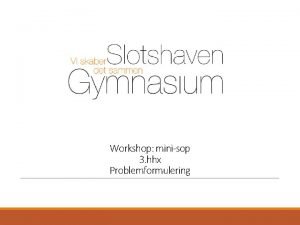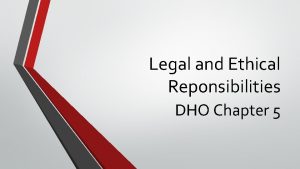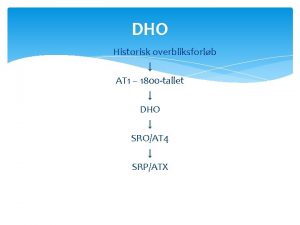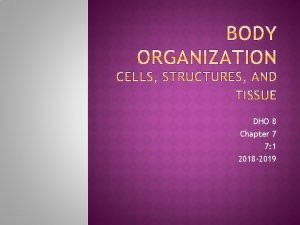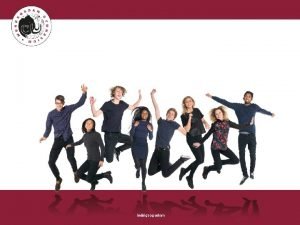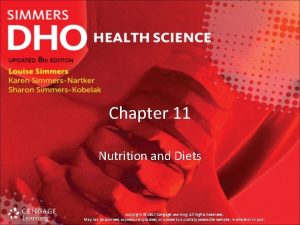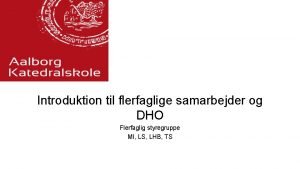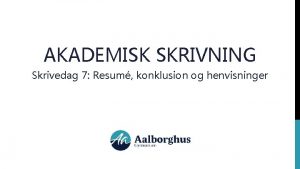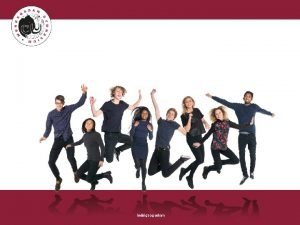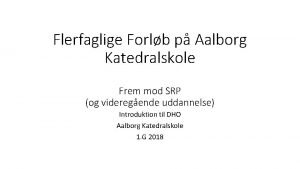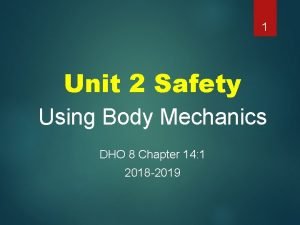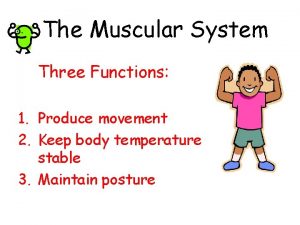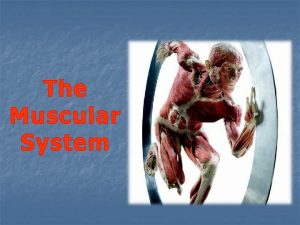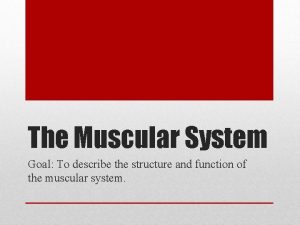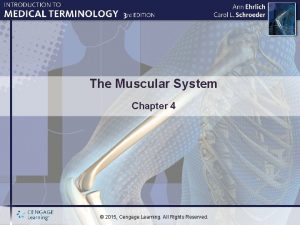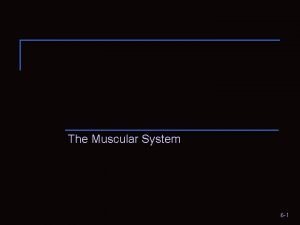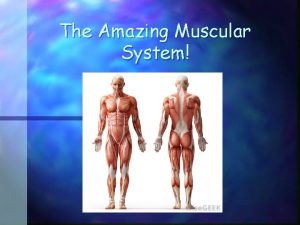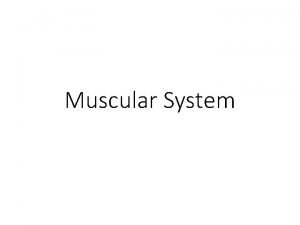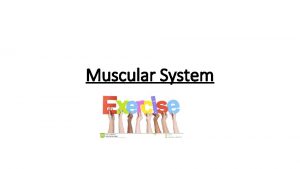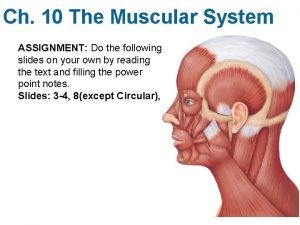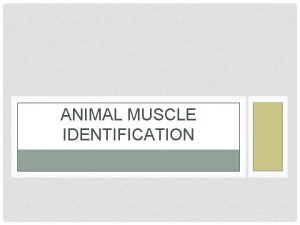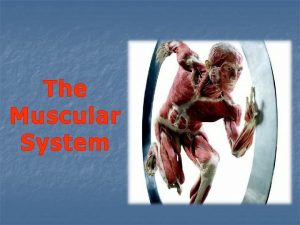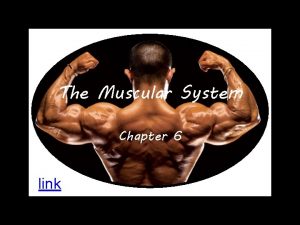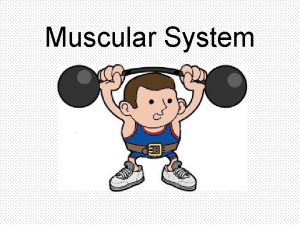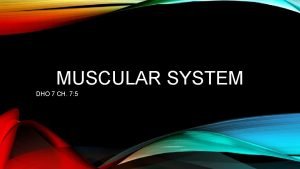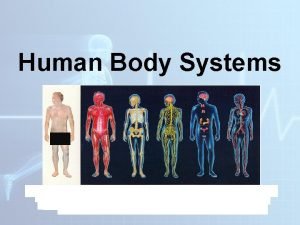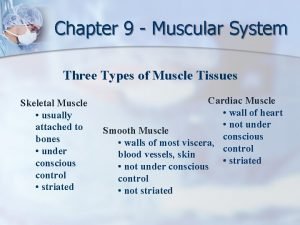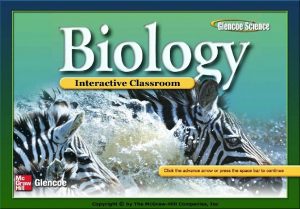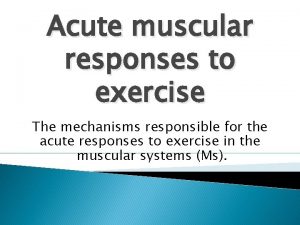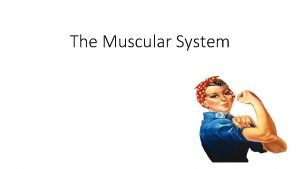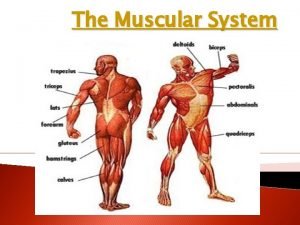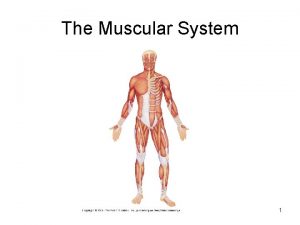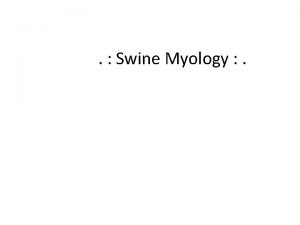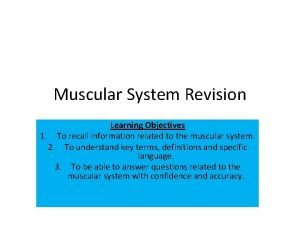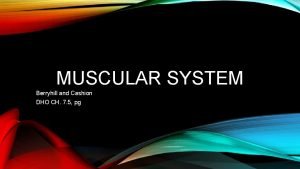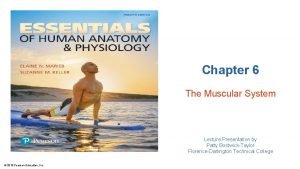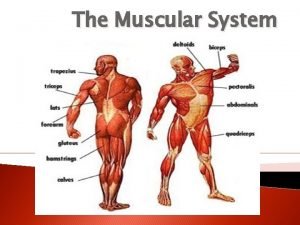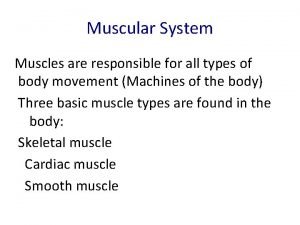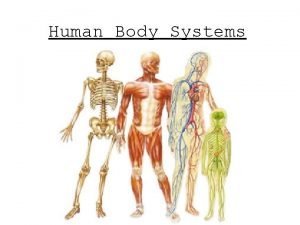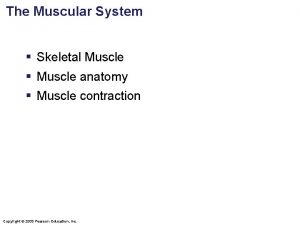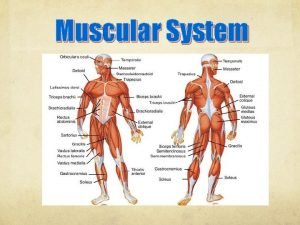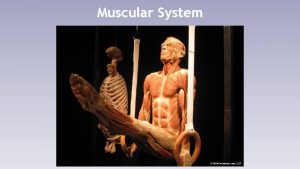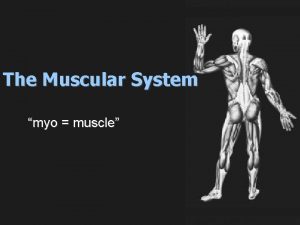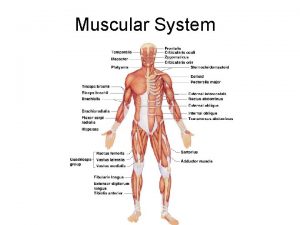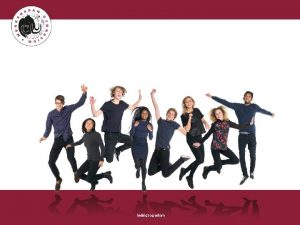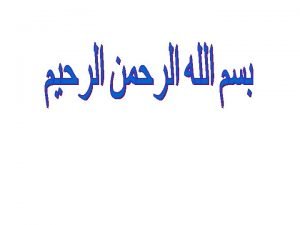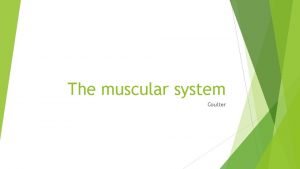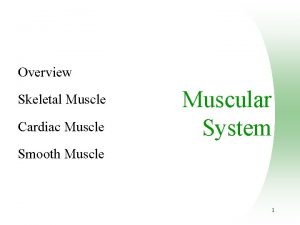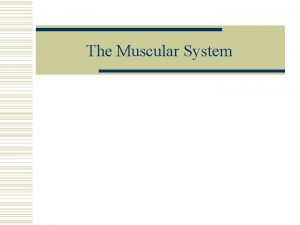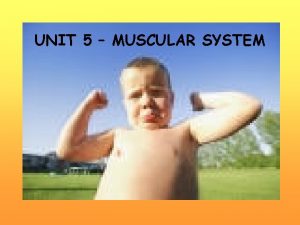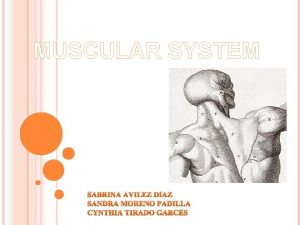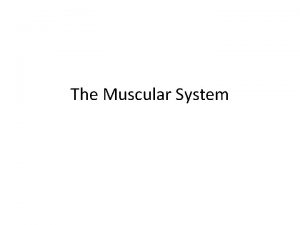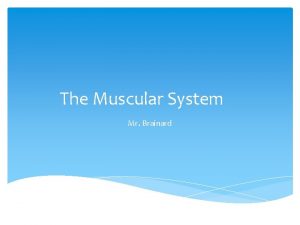MUSCULAR SYSTEM DHO 7 CH 7 5 MUSCLE





















































- Slides: 53

MUSCULAR SYSTEM DHO 7 CH. 7: 5

MUSCLE FACTS: v. There are more than 600 muscles v. Muscles are bundles of muscle fibers held together by connective tissue.

CHARACTERISTICS OF ALL MUSCLES: v. Excitability – irritability, the ability to respond to a stimulus such as a nerve impulse {receives & responds to stimuli}

CHARACTERISTICS OF ALL MUSCLES: v. Contractibility – muscle fibers that are stimulated by nerves contract (become short and thick), which causes movement {able to shorten & thicken}

CHARACTERISTICS OF ALL MUSCLES: v. Extensibility – the ability to be stretched {able to stretch without damage}

CHARACTERISTICS OF ALL MUSCLES: v. Elasticity –allows the muscle to return to its original shape after it has contracted or stretched {able to return to shape}

https: //www. youtube. com/watch? v=d 8 mop 0 Vx. YFE&list=P L 5 Si 5 JKjk 6 d. Pfcr 1 hcw 8 zb 9 K 67 wu 9 zof. T&t=0 s&index=2

MUSCLE CONTROL Muscles can be voluntary or involuntary. ØVoluntary – you have control over its action; example moving your arm ØInvoluntary – they function without conscious thought or control; example your diaphragm muscle for breathing

3 KINDS OF MUSCLE: 1. Cardiac – forms the walls of the heart; contracts to circulate blood

TEST YOUR KNOWLEDGE Is cardiac muscle voluntary or involuntary? üINVOLUNTARY

3 KINDS OF MUSCLE: 2. Visceral (smooth) – found in the internal organs (digestive and respiratory system), blood vessels, and eyes; contract to cause movement in these organs.

TEST YOUR KNOWLEDGE Is visceral muscle voluntary or involuntary? üINVOLUNTARY

3 KINDS OF MUSCLE: 3. Skeletal – attached to bones; contracts to cause body movement

TEST YOUR KNOWLEDGE Is skeletal muscle voluntary or involuntary? üVOLUNTARY

FUNCTIONS OF SKELETAL MUSCLE: 1. Attach to bones to provide voluntary movement 2. Produce heat and energy for the body 3. Help maintain posture by holding the body erect 4. Protect internal organs

DO YOU KNOW? • One of the characteristics of muscle is extensibility. This allows muscles to: A) React to an impulse B) Contract C) Stretch D) Consume oxygen And the answer is…C

LECTURE 2, SLIDES 16 -24 Objectives: To describe the process of muscle contraction through attachment, and origin and insertion

DO YOU KNOW? • Which of the following is a characteristic of muscles? A) Excitability B) Portability C) Stability D) Feasibility And the answer is…A

DO YOU KNOW? • Where would you find a voluntary muscle? A) In blood vessel walls B) Attached to the femur C) Inside the heart D) Lining the stomach And the answer is…B

DO YOU KNOW? • After you swallow food, what kind of muscle moves the food toward your stomach? A) Cardiac B) Skeletal C) Voluntary D) Smooth And the answer is…D

SKELETAL MUSCLE: Skeletal muscles attach to bones in different ways: • Tendons – strong, tough, fibrous connective tissue cords that can attach muscles to bones. ex: gastrocnemius on the calf attaches to heel bone by Achilles tendon

TENDONS

• Fascia – tough, sheet-like membrane that covers and protects the muscle tissue ex: deep muscles of the trunk and back are surrounded by the lumbodorsal fascia

FASCIA

ORIGIN VS INSERTION: • When a muscle attaches to a bone, the end that does not move is called the origin. • The end that moves when the muscle contracts is called the insertion.

ORIGIN VS INSERTION: Example: the origin of the deltoid (shoulder muscle) is by the clavicle & scapula. Its insertion is on the humerus. When the deltoid contracts, the area by the scapula remains stationary, but the area by the humerus moves and abducts the arm away from the body.

ORIGIN VS INSERTION

ORIGIN VS INSERTION

LECTURE 3, SLIDES 25 -33 Objectives: To identify the vocabulary associated with active and passive range of motion

MUSCLE VOCABULARY: §Superficial – closer to the surface of the body §Deep – farther away from the surface of the body

MUSCLE VOCABULARY: Back muscles from superficial to deep

MUSCLE VOCABULARY: §Muscle tone – state of partial contraction or readiness to act. Muscles are partially contracted at all times, even when not in use. {the state of muscle tension inside a muscle when it’s at rest}

MUSCLE VOCABULARY: Muscle Tone How alert are your muscles?

MUSCLE VOCABULARY: §Muscle atrophy – muscles shrink in size and lose strength; can occur in severe illness (paralysis) when muscles aren’t used for a longtime

MUSCLE VOCABULARY: • Muscle atrophy

MUSCLE VOCABULARY: §Contracture – lack of use resulting in a severe tightening of a flexor muscle resulting in bending of a joint ex: foot drop, but can also happen to the fingers, wrists, knees, & other joints

MUSCLE VOCABULARY: Contractures

DO YOU KNOW? • When a muscle attaches to a bone, the end that does not move is the: A) Tendon B) Root C) Origin D) Insertion And the answer is…C

DO YOU KNOW? • Of the following, what muscle is superior to the other three? A) Intercostals B) Gastrocnemius C) Sternocleidomastoid D) Trapezius And the answer is…C

DO YOU KNOW? • Which muscle would do the most work if you ran 5 miles? A) Sternocleidomastoid B) Quadriceps femoris C) Biceps D) Pectoralis major And the answer is…B

DO YOU KNOW? • What muscle is located above the waist? A) Deltoid B) Tibialis anterior C) Gastrocnemius D) Gluteus maximus And the answer is…A

DO YOU KNOW? • Karina’s leg was in a cast for ten weeks. You would expect her leg muscles to experience some degree of : A) Atrophy B) Hypertrophy C) Circumduction D) Rotation And the answer is…A

DO YOU KNOW? • What would cause a muscle contracture? A) Twisting B) Pulling C) Lack of use D) Overuse And the answer is…C

LECTURE 4, SLIDES 34 -43 Objectives: To identify active and passive range of motion To identify the different patient positions Anatomical Movements Rap (Buzzin remix) https: //www. youtube. com/watch? v=Zl. FOge. MT 8 FA

TYPES OF MUSCLE MOVEMENTS: 1. Adduction – moving a body part toward the midline 2. Abduction – moving a body part away from the midline

3. Flexion – decreasing the angle between 2 bones, or bending a body part 4. Extension – increasing the angle between 2 bones, or straightening a body part TYPES OF MUSCLE MOVEMENTS:

TYPES OF MUSCLE MOVEMENTS: 5. Rotation – turning a body part around its own axis 6. Circumduction – moving in a circle at a joint or moving one end of a body part in a circle while the other end remains stationary

TYPES OF MUSCLE MOVEMENTS: 7. Supination – turning a body part upward 8. Pronation – turning a body part downward

POSITIONING A PATIENT: • Semi-Fowlers – HOB 45 degrees

POSITIONING A PATIENT: • Supine (horizontal recumbent) – flat on the back

POSITIONING A PATIENT: • Prone – pt lies on their abd

POSITIONING A PATIENT: • Left lateral (Sims’) – pt lies on their left side

POSITIONING A PATIENT: • Trendelenburg – pt lies on their back with their head lower than their feet
 Plyometrics disadvantages
Plyometrics disadvantages Chapter 7:11 digestive system
Chapter 7:11 digestive system Smooth muscle fusiform
Smooth muscle fusiform _____ muscles run across the cheek.
_____ muscles run across the cheek. Sop hhx problemformulering
Sop hhx problemformulering Dho chapter 5 legal and ethical responsibilities
Dho chapter 5 legal and ethical responsibilities Dho hhx
Dho hhx Dho emner historie
Dho emner historie Dho chapter 7
Dho chapter 7 Disposition dho
Disposition dho Dho mundtlig eksamen
Dho mundtlig eksamen Dho kvinders rettigheder
Dho kvinders rettigheder Chapter 11 nutrition and diet
Chapter 11 nutrition and diet Vietnamkrigen srp
Vietnamkrigen srp Dho chapter 4
Dho chapter 4 Konklusion eksempel
Konklusion eksempel Dho skrivning
Dho skrivning Hvad sker der hvis man dumper srp
Hvad sker der hvis man dumper srp Den videnskabelige basismodel
Den videnskabelige basismodel Chapter 7 safety and body mechanics
Chapter 7 safety and body mechanics Three functions of muscular system
Three functions of muscular system Which is a primary function of the muscular system
Which is a primary function of the muscular system 2 functions of muscles
2 functions of muscles Chapter 4 the muscular system learning exercises answer key
Chapter 4 the muscular system learning exercises answer key Unit 6:5 muscular system
Unit 6:5 muscular system Simple muscular system diagram
Simple muscular system diagram Greek word for muscle
Greek word for muscle Muscular system label
Muscular system label Rectus femoris fascicle arrangement
Rectus femoris fascicle arrangement Muscular system head and neck
Muscular system head and neck Brachiocephalicus
Brachiocephalicus Navigating the body muscular system #3
Navigating the body muscular system #3 Whats the function of the muscular system
Whats the function of the muscular system Chapter 6 the muscular system figure 6-9
Chapter 6 the muscular system figure 6-9 Purpose of muscular system
Purpose of muscular system Test chapter 7:5 muscular system
Test chapter 7:5 muscular system Chapter 9 muscular system
Chapter 9 muscular system Sarcomore
Sarcomore Structures of the muscular system
Structures of the muscular system Chapter 32 section 3 the muscular system answer key
Chapter 32 section 3 the muscular system answer key Muscular system response to exercise
Muscular system response to exercise How your muscular system works
How your muscular system works Muscular system diagram
Muscular system diagram Dorsifelxion
Dorsifelxion Muscular system levels of organization
Muscular system levels of organization Superficial muscular system
Superficial muscular system Muscles
Muscles Muscular system learning objectives
Muscular system learning objectives Chapter 7:5 muscular system
Chapter 7:5 muscular system Chapter 6 the muscular system
Chapter 6 the muscular system Cengage chapter 4 answers
Cengage chapter 4 answers What are the major functions of the muscular system
What are the major functions of the muscular system Muscular system means
Muscular system means 3 functions of the muscular system
3 functions of the muscular system




